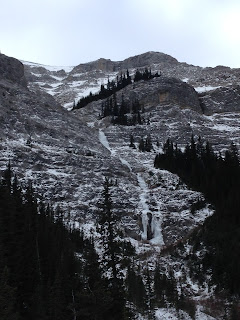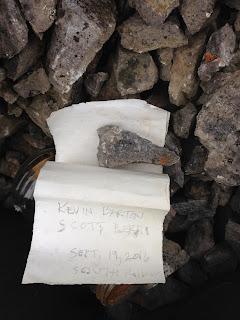August 5 had an absolutely great day on the obscure, but grand, Mount
Jerram. Mt. Jerram is located in the Opal Range, between Elpoca Mountain and
Mount Burney. This summit is the ninth
highest in the Opal Range and one of the more significant mountains in this
part of Kananaskis. There were only two
recorded ascents prior to our successful summit on August 5, 2016. First ascent by Don Morrison and Jim Tarrant
via West Ridge, then West Face to summit ridge and top in June of 1957. Second ascent by Rick Collier and Jim Holmes
on July 19, 1998, with a variation on the upper face to gain the summit ridge
more to the north. Andrew Nugara and I
followed the Collier/Holmes variation to reach the summit. Both previous parties did bivy in upper King
Creek, but Andrew and I day tripped the climb with a long day, about 16 hours
car to car.
Parked at Opal Creek turnoff, approach road to Valleyview Trail, along
Highway 40, about 5 km south of the Peter Lougheed Provincial Park turnoff/King
Creek parking lot. A really great trail
winds up northern edge of Opal Creek and leads one to the scree slope north of
Opal Falls (White Man Falls). The trail starts just slightly upstream of the
recently upgraded bridge (2016?) that crosses Opal Creek on the left side
(north side) of creek. The lower section heads north, away from the creek on
the top of the short bank, definitely worthwhile locating this trail. After a short distance in the forest, the
trail returns to the sharp northern edge of the creek valley and traverses to
the open scree slopes, head north to a steep scree slope that heads east, uphill. Ascending this steep scree slope is essential
to accessing upper Opal Creek since the gap between Mt. Wintour and “Opoca
Peak” (GR368155) is narrow and cliffy with Opal Falls creating a dangerous
barrier.
Once above this steep scree, a huge trail leads one into the upper Opal
Creek valley, where the trail disappears quickly, but mostly light bushwhacking
allows easy access anywhere in this beautiful subalpine valley. Hike to the obvious West Ridge of Mt. Jerram,
basically above the Mt. Wintour/Mt. Jerram col, the Opal Creek/King Creek
divide. The bottom of the West Ridge is vertical, so we accessed the middle
section of the ridge via scree slopes from the basin between the West Ridge and
the South-West Ridge. Moderate scrambling up the West Ridge ends a short flat
section where ridge ends on the steep West Face. This is the first pitch of
fifth class climbing, a nice 30 metre pitch of 5.4 on mostly solid rock, but
little protection.
 |
View to West Face of Mt. Jerram. Scramble in orange line, pitches of 5 class in red. Pitches labeled P.
(Photo taken last fall, 2015) |
 |
| Nearing start of scramble on middle section of West Ridge. |
 |
| Typical terrain on mid section of West Ridge. |
 |
| A few steeper sections on West Ridge. |
 |
| Andrew having too much fun! |
 |
| View to Mt. Burney from West Ridge; been there done that, also with Andrew. |
Once above this section, a scree slope heads up, then angles left, staying
on scree, head up to a faint ridge line above, then from this ridge line, still
on scree, head up to the base of a dark gully. Two gullies start near the same
spot, take the right hand gully (southern) which is taller and wider at the
base. The back of the gully was wet on
our ascent.
 |
| View to 5.4 pitch. |
 |
| Above 5.4 pitch, follow scree up, then left on scree. |
 |
| OSWB leading 5.5 gully pitch. |
Although technically easier, 5.5 versus 5.6, I would say this gully
pitch is the crux, the moves are only 5.5, but you must stem crazy wide and
totally commit to some very awkward moves to surmount the first overhang, not
too technical, but demanding climbing; at least for me. Thankfully there is
great protection from cam or wires along the lower section, right hand side, in
the great hand crack, then less protection above the overhang, but the climbing
is easier, 5.3 to 5.4 ish.
 |
| View to Andrew on second, finishing gully pitch. |
 |
| OSWB above halfway up to the ridge on super loose 5.6; no pro. |
About 30 metres in the gully leads to a scree gully that leads the top
of a notch in the summit ridge. Belayed off a solid rock horn, brought up
Andrew and set up for my last rock lead.
Rick Collier’s trip report indicated they went up to the notch, then
took the ridge line (tower) out of the narrow notch to the summit. There was a
small low angled slab face, then a steep face that lead directly to the ridge,
I took this line instead of heading up scree to the notch; seemed more direct. Definitely 5.6 climbing and extremely loose
rock, but the worst rock quality section was where I gained the ridge, very
exposed and the rock just peeled off the mountain. Once on the ridge the
climbing became a loose moderate scramble to the summit cairn, about 30 metres
from gaining the ridge.
 |
| Summit smiles. |
 |
| On descent, OSWB taking a few last summit photos. |
 |
| Summit view to Andrew at our first rappel station. |
About 8 hours after leaving the car Andrew and I reached the seldomly
visited summit of Mount Jerram. The sky was a bit threatening with some dark
cloud bottoms, but the advantage point and view from the summit was so spectacular
we had to linger and take a lot of photos.
Filled out the register and slowly began our descent. We used a piton placed by Rick Collier in
1998 as part of our first rappel station (backed up by a sling on a large
boulder). Rapped to the top of the 5.5 gully pitch, rapped off the rock belay
horn to the base on the gully; two rappels to the scree, good rappel anchors
(cord with locking biner) left in place.
Rick and Jim were descending with a thunderstorm pending and to save
time they avoided rappelling the lowest 5.4 pitch section by descending ribs
and scree gullies along the big broad lower west face. We thought this could
save time and tried this descent. Not
recommended. I would recommend rapping
the 5.4 section and descending the west ridge. The descent down the big face
was painful with us getting cliffed out on top of many big drops that then
required climbing up to attempt the next scree gully. Big waste of time, but we eventually got
down.
 |
| OSWB frigging around with the rope on the traverse rappel from the first rap station. |
Once back at the lowest scree field, just a simple plod back to the
car. Nearing the cliffs near Opal Falls, we had a very tough time staying on
the thin game trail by headlamp and wasted at least one hour traversing up and
down trying to find the safe exit to the lower valley scree slopes; exhausting
time. Once back in the lower valley we
were quite happy to plod to the car, about 16 hours car to car. Great day out with a good friend and I will enjoy
these memories for years!




















































